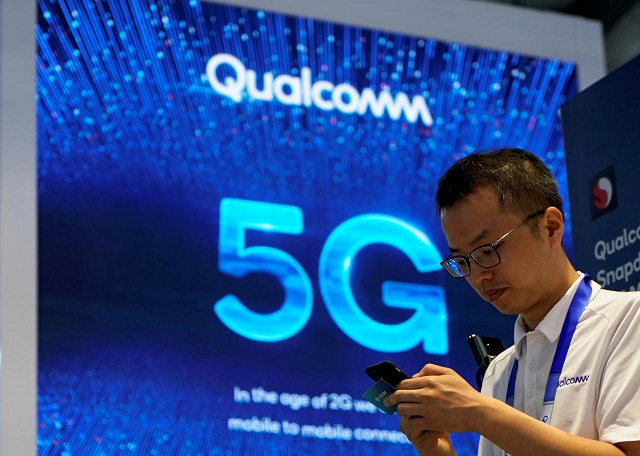
Fifth-generation chipsets from Qualcomm, the world’s biggest supplier of mobile phone chips, now run on five devices from Samsung Electronics, including the $1,299 Galaxy S10 5G model and the new $2,000 Galaxy Fold.
Samsung, the world’s top smartphone seller, has also put Qualcomm chips in its lower-priced A90 5G model, which had used Samsung chips in an earlier version.
Qualcomm President Cristiano Amon predicted such devices would achieve volume and scale.
From Next Year: Qualcomm to put 5G chips in phones
“The transition to 5G is going to be faster than earlier transitions,” Amon told Reuters on the sidelines of the IFA consumer electronics fair in Berlin.
“Now we have to bring it to everyone.”
More than 20 network operators and a similar number of smartphone makers - from the United States to Europe to China - are launching 5G services and handsets. Amon estimated there were 2.2 billion mobile users that could upgrade.
Such bullishness contrasts with the challenges faced by China’s Huawei, the No.2 smartphone seller behind Samsung that also unveiled its 5G chipset at IFA.
Huawei’s consumer business chief Richard Yu touted the Kirin 990 chipset at IFA as the “most powerful” and superior to Qualcomm’s Snapdragon 8 series.
Due to US trade sanctions, Huawei’s 5G-ready Mate 30 smartphone range to be launched on September 19 could be hobbled because it won’t be able to run the official version of Google’s Android operating system and app services.
MASS APPEAL
Until now, Qualcomm typically supplied 5G chips from its most expensive line, Snapdragon 8, which on Friday was showcased with a more powerful X55 5G modem delivering speeds of up to 7 gigabits per second.
It now plans to add 5G capabilities to lower-cost Snapdragon 6 and 7 series devices, which could make 5G phones available more cheaply than the current mostly premium models.
Qualcomm’s 6 and 7 series Snapdragon chips are found in devices from Lenovo, Motorola, Xiaomi, Oppo and Vivo that retail in the $300 range.
Huawei tests smartphone with own operating system, possibly for sale this year
Analysts say faster 5G networks will spur many consumers to upgrade their phones after years of market stagnation, although 5G devices are coming to some markets before networks are completed.
“Qualcomm have done a phenomenal job to drive the 5G ecosystem,” said industry analyst Paolo Pescatore.
“It’s going faster than anyone could have ever imagined.”
That puts a premium for Qualcomm on partnering with carriers to market new devices. It’s typical for operators to market subsidised handsets in the United States, but less so in Europe.
In Germany, Deutsche Telekom switched on its 5G network in five cities this week, marketing the Snapdragon-powered Samsung Galaxy S10 5G to early adopters.
FULL SPECTRUM
Qualcomm was early to market 5G modem chips to connect phones to networks but faces intense competition. Taiwan-based MediaTek also announced a 5G smartphone chip this year.
Qualcomm is positioning itself to be compatible with the full range of frequencies deployed by regulators to run 5G.
These include so-called ‘sub-6’, or spectrum below 6 Gigahertz that has been predominantly auctioned by European governments making an early start on the shift to 5G.
The United States has auctioned more millimeter wave frequencies with a shorter range but higher data-carrying capacity needed to realize the full range of uses of 5G, such as autonomous driving.
Huawei outlines investment plans in Poland depending on 5G role
Unlike rivals, Qualcomm is designing its chipsets to handle frequencies “from A to Z”, said Amon, adding that flexibility to switch between 4G networks and new 5G networks was critical.
Chips from Mediatek can only handle sub-6 bands, reducing the cost and complexity of the chips and phone designs.
But it means the phones cannot take full advantage of networks from US carriers such as Verizon Communications and AT&T that use millimeter wave technology.


















1713904359-0/burn-(1)1713904359-0-270x192.webp)
















1713853507-0/MalalaHilary-(2)1713853507-0-270x192.webp)







COMMENTS
Comments are moderated and generally will be posted if they are on-topic and not abusive.
For more information, please see our Comments FAQ